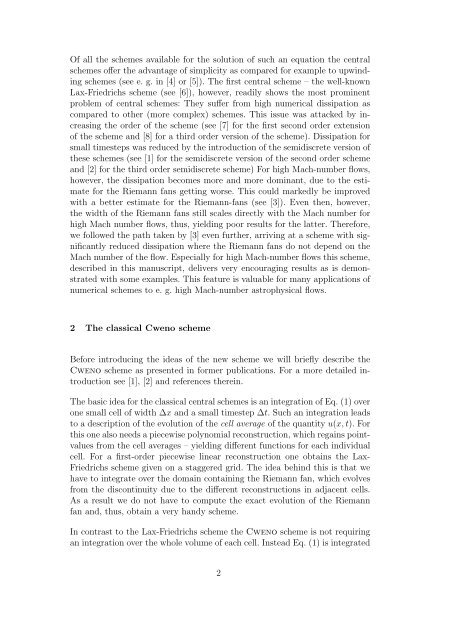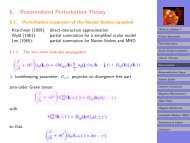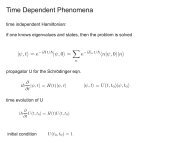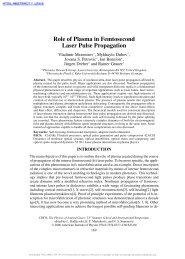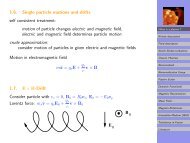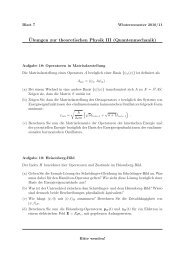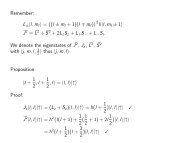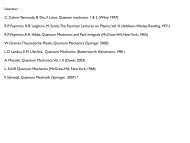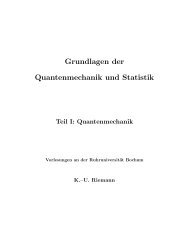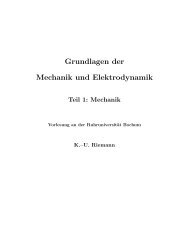Download (pdf 0.3MB) - Institut für Theoretische Physik I - Ruhr ...
Download (pdf 0.3MB) - Institut für Theoretische Physik I - Ruhr ...
Download (pdf 0.3MB) - Institut für Theoretische Physik I - Ruhr ...
Create successful ePaper yourself
Turn your PDF publications into a flip-book with our unique Google optimized e-Paper software.
Of all the schemes available for the solution of such an equation the central<br />
schemes offer the advantage of simplicity as compared for example to upwinding<br />
schemes (see e. g. in [4] or [5]). The first central scheme – the well-known<br />
Lax-Friedrichs scheme (see [6]), however, readily shows the most prominent<br />
problem of central schemes: They suffer from high numerical dissipation as<br />
compared to other (more complex) schemes. This issue was attacked by increasing<br />
the order of the scheme (see [7] for the first second order extension<br />
of the scheme and [8] for a third order version of the scheme). Dissipation for<br />
small timesteps was reduced by the introduction of the semidiscrete version of<br />
these schemes (see [1] for the semidiscrete version of the second order scheme<br />
and [2] for the third order semidiscrete scheme) For high Mach-number flows,<br />
however, the dissipation becomes more and more dominant, due to the estimate<br />
for the Riemann fans getting worse. This could markedly be improved<br />
with a better estimate for the Riemann-fans (see [3]). Even then, however,<br />
the width of the Riemann fans still scales directly with the Mach number for<br />
high Mach number flows, thus, yielding poor results for the latter. Therefore,<br />
we followed the path taken by [3] even further, arriving at a scheme with significantly<br />
reduced dissipation where the Riemann fans do not depend on the<br />
Mach number of the flow. Especially for high Mach-number flows this scheme,<br />
described in this manuscript, delivers very encouraging results as is demonstrated<br />
with some examples. This feature is valuable for many applications of<br />
numerical schemes to e. g. high Mach-number astrophysical flows.<br />
2 The classical Cweno scheme<br />
Before introducing the ideas of the new scheme we will briefly describe the<br />
Cweno scheme as presented in former publications. For a more detailed introduction<br />
see [1], [2] and references therein.<br />
The basic idea for the classical central schemes is an integration of Eq. (1) over<br />
one small cell of width ∆x and a small timestep ∆t. Such an integration leads<br />
to a description of the evolution of the cell average of the quantity u(x, t). For<br />
this one also needs a piecewise polynomial reconstruction, which regains pointvalues<br />
from the cell averages – yielding different functions for each individual<br />
cell. For a first-order piecewise linear reconstruction one obtains the Lax-<br />
Friedrichs scheme given on a staggered grid. The idea behind this is that we<br />
have to integrate over the domain containing the Riemann fan, which evolves<br />
from the discontinuity due to the different reconstructions in adjacent cells.<br />
As a result we do not have to compute the exact evolution of the Riemann<br />
fan and, thus, obtain a very handy scheme.<br />
In contrast to the Lax-Friedrichs scheme the Cweno scheme is not requiring<br />
an integration over the whole volume of each cell. Instead Eq. (1) is integrated<br />
2


